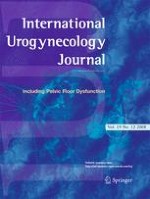Published in:

01-12-2008 | Original Article
Urodynamic characterization of obese women with urinary incontinence undergoing a weight loss program: the Program to Reduce Incontinence by Diet and Exercise (PRIDE) trial
Authors:
Holly E. Richter, Jennifer M. Creasman, Deborah L. Myers, Thomas L. Wheeler, Kathryn L. Burgio, Leslee L. Subak, for the Program to Reduce Incontinence by Diet and Exercise (PRIDE) Research Group
Published in:
International Urogynecology Journal
|
Issue 12/2008
Login to get access
Abstract
The purpose of this study was to describe urodynamic characteristics of overweight or obese women with urinary incontinence and explore the relationship between urodynamic parameters, body mass index (BMI), and abdominal circumference (AC). One hundred ten women underwent a standardized cough stress test and urodynamic study. Eighty-six percent of women had urodynamic stress incontinence and 15% detrusor overactivity. Intra-abdominal pressure (Pabd) at maximum cystometric capacity (MCC) increased 0.4 cm H2O per kg/m2 unit of BMI (95% confidence interval [CI] = 0.0,0.7, p = 0.04) and 0.4 cm H2O per 2 cm increase in AC (CI = 0.2, 0.7, p < 0.01). Intravesical pressure (Pves) at MCC increased 0.4 cm H2O per 2 cm increase in AC (CI = 0.0, 0.8, p = 0.05) but was not associated with BMI (p = 0.18). BMI and AC had a stronger association with Pabd than with Pves, suggesting a possible mechanism for the association between obesity and urinary incontinence.





